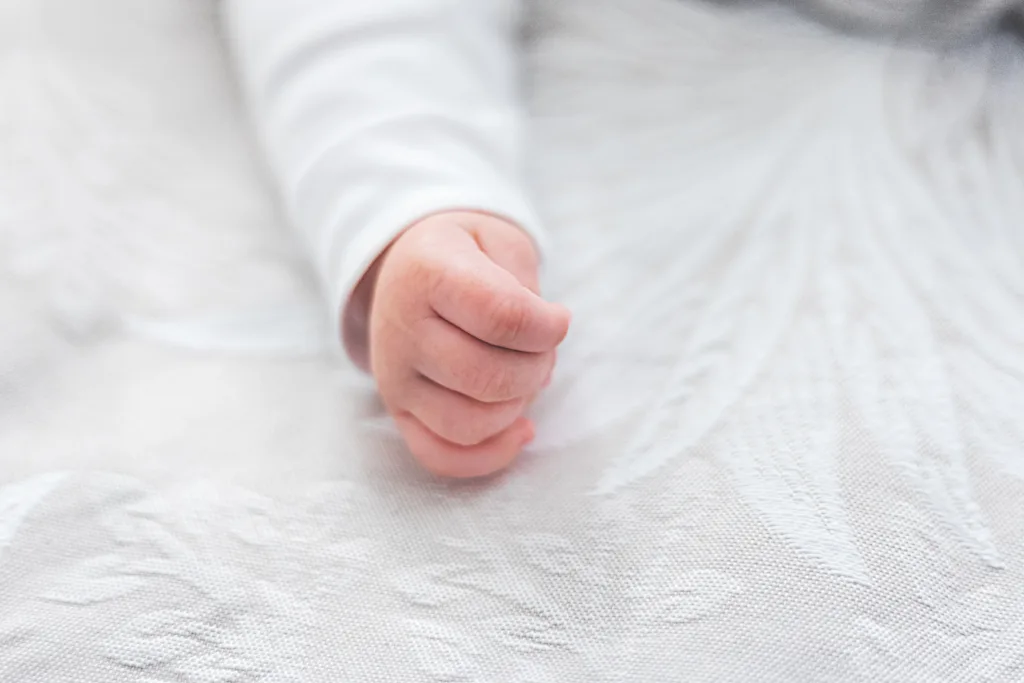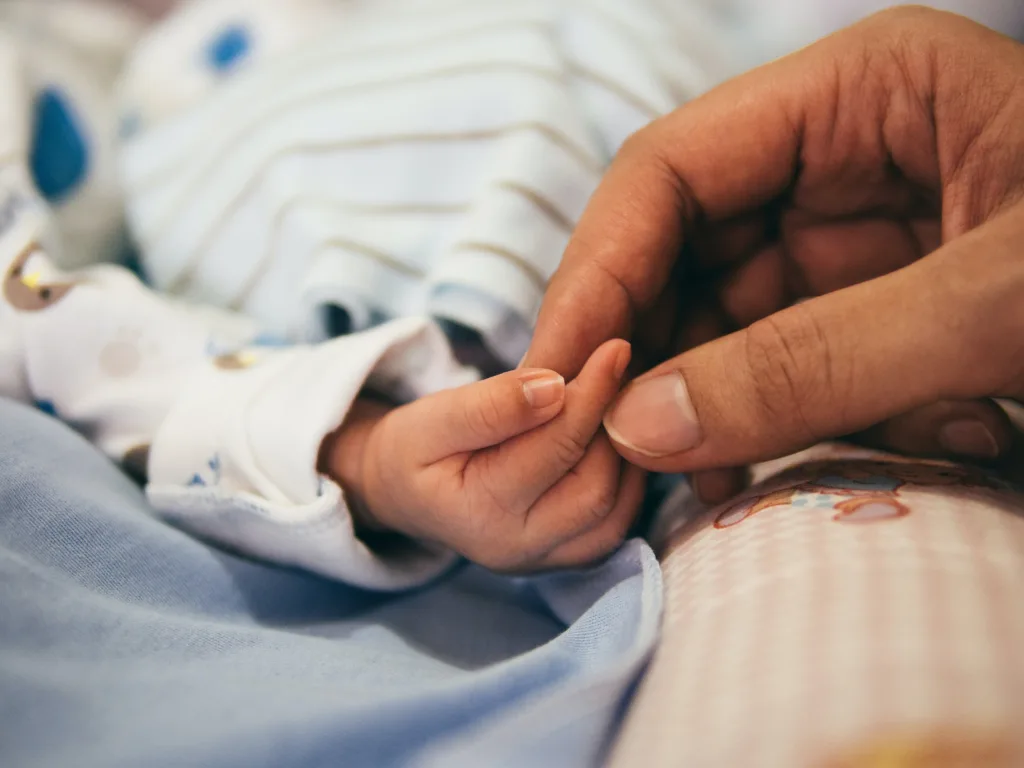Babies are fascinating little beings, constantly developing and growing inside the womb. One of the most intriguing aspects of their development is the formation of their unique fingerprints. These tiny ridges and patterns on their fingertips play a crucial role in their identification and are a testament to the marvels of nature.
At around 9 weeks from conception, the unborn baby starts showing signs of dexterity. If you were to place an object in their palm, they would instinctively curl their fingers around it. This reflex, known as the grasp reflex, is an early indication of their developing motor skills. It is during this time that the groundwork for their fingerprints begins.
Around this stage, the baby’s skin starts to form distinct ridges and furrows on the fingertips. These ridges are what give rise to the intricate patterns we commonly refer to as fingerprints. As the baby continues to grow, the patterns become more defined and unique to each individual. In fact, fingerprints are so unique that no two people in the world have the exact same set of prints.
But have you ever wondered why some people don’t have fingerprints? A rare condition known as adermatoglyphia, also called “immigration delay disease,” causes individuals to be born without fingerprints. This condition is caused by a genetic mutation that affects the formation of these ridges during fetal development. While it may seem like a minor inconvenience, this lack of fingerprints can have significant implications in identification processes.
Fingerprints play a crucial role in verifying a person’s identity. They are widely used in various fields, including law enforcement, border control, and even everyday activities like unlocking smartphones. In the case of babies, fingerprints are essential in preventing misidentification and creating accurate birth certification data.
When a baby is born in a hospital, their fingerprints are often taken as part of the identification process. This ensures that the child’s identity can be verified when checking out and provides a reliable record of their birth in that specific hospital. These records are vital for legal and administrative purposes, and having accurate fingerprints helps avoid any confusion or mix-ups.
It’s truly remarkable how something as small as fingerprints can have such a significant impact on our lives. From the moment a baby first curls their tiny fingers around an object, the groundwork for their unique prints begins. These patterns, formed through intricate processes during fetal development, serve as a testament to their individuality and play a crucial role in their identification throughout their lives.
As we continue to marvel at the wonders of human development, let us appreciate the uniqueness of our fingerprints and the role they play in our lives. From the tiniest of babies to the oldest of adults, our fingerprints are a reminder of the intricate and awe-inspiring nature of our existence.
What Week Do Babies Get Fingerprints?
Babies develop their fingerprints during week 23 of pregnancy, which is approximately 21 weeks after conception. At this stage, the baby’s skin is starting to become more developed, and the unique ridges and patterns that make up fingerprints begin to form. These fingerprints are formed as the baby’s skin layers grow and fold, creating the distinctive patterns that we associate with fingerprints.
It’s interesting to note that fingerprints are not only unique to each individual, but they are also formed very early on in fetal development. By the time a baby is born, their fingerprints are already fully formed and can be identified. This makes fingerprints a valuable tool in identifying individuals and is often used in forensic science and criminal investigations.
The development of fingerprints is a fascinating process that occurs during the second trimester of pregnancy. Here is a breakdown of the timeline leading up to the formation of fingerprints:
1. Week 9-12: By this stage, the baby’s skin is developing, and the epidermis, which is the outermost layer of the skin, starts to form.
2. Week 13-16: The dermis, which is the layer beneath the epidermis, begins to develop. This layer is responsible for providing strength and support to the skin.
3. Week 17-21: The ridges and valleys that will eventually form the unique patterns of fingerprints start to appear. These patterns are influenced by genetic factors and other environmental factors within the womb.
4. Week 22-26: The ridges on the baby’s fingers and palms become more pronounced, and the patterns continue to develop and refine.
By week 23, the fingerprints have usually formed and are recognizable. It’s important to note that while fingerprints are typically fully formed by this stage, they may continue to develop and change slightly throughout the remainder of the pregnancy.
Babies develop their fingerprints around week 23 of pregnancy. The formation of fingerprints is a complex process that occurs during the second trimester, as the baby’s skin layers grow and fold, creating the unique patterns we associate with fingerprints.

Are Babies Born Without Fingerprints?
It is a known fact that almost every person is born with fingerprints, as fingerprints start forming in the womb around the 10th week of pregnancy. However, there is a rare genetic condition called adermatoglyphia, also known as “immigration delay disease” or “immigration delay syndrome,” where individuals are born without fingerprints.
Adermatoglyphia is an extremely rare condition, with only a few known cases reported worldwide. It is caused by a mutation in a specific gene called SMARCAD1, which affects the development of the ridges and patterns on the skin, including fingerprints. People with adermatoglyphia have smooth and featureless fingertips instead of the unique ridges and patterns that form the basis of fingerprints.
The lack of fingerprints in individuals with adermatoglyphia can have various implications. For example, fingerprints are commonly used for identification purposes, such as for passports, visas, and other official documents. Therefore, individuals with this condition may face challenges when it comes to identification and may require alternative methods of identification.
Additionally, fingerprints play a crucial role in enhancing grip and dexterity, allowing us to grasp objects more firmly. People with adermatoglyphia may experience difficulties with tasks that require a strong grip, such as holding onto objects or performing certain manual tasks.
It is worth noting that adermatoglyphia is not associated with any other major health problems or medical complications. Apart from the absence of fingerprints, individuals with this condition typically lead normal lives and do not experience any significant health issues directly related to adermatoglyphia.
While the vast majority of individuals are born with fingerprints, a small number of people have a rare genetic condition called adermatoglyphia, which causes them to be born without fingerprints. This condition is caused by a mutation in the SMARCAD1 gene and can have implications for identification and grip-related activities. However, it does not typically lead to any other significant health problems.
Why Are Babies Fingerprinted At Birth?
Babies are fingerprinted at birth for several important reasons:
1. Identification: Fingerprinting helps ensure accurate identification of newborns, preventing any mix-ups or confusion. Each person has a unique set of fingerprints, which remain consistent throughout their lives. By capturing a baby’s fingerprints at birth, hospitals can create a reliable record of their identity, reducing the chances of misidentification.
2. Security: Fingerprinting enhances the security measures in hospitals and healthcare facilities. By linking a baby’s fingerprints to their medical records, healthcare providers can ensure that only authorized individuals have access to sensitive information or are allowed to handle the baby. This helps protect newborns from potential risks or unauthorized access.
3. Birth certification: Fingerprinting is also used to create birth certification data. By capturing a baby’s fingerprints, hospitals can generate official documentation that certifies the baby’s birth at that particular hospital. This record becomes a crucial legal document for the child’s identity, which can be used for various purposes throughout their life, such as obtaining identification documents or proving parentage.
4. Forensic purposes: Although rare, fingerprints collected at birth can also serve forensic purposes in case of emergencies, accidents, or criminal investigations. If needed, these fingerprints can be used to establish the identity of a child involved in such situations, aiding law enforcement agencies in their efforts.
Fingerprinting newborns at birth is a proactive measure to ensure accurate identification, enhance security, create birth certification data, and potentially assist in forensic situations. This process helps hospitals maintain proper records and safeguards the well-being and identity of newborns.
Does A Baby Have Fingerprints At 9 Weeks?
At 9 weeks from conception, a developing baby does indeed have fingerprints. This is a fascinating and unique characteristic that begins to form during this stage of prenatal development. The development of fingerprints is a complex process that involves the growth and differentiation of the skin ridges on the fingers.
Here are some key points to consider:
1. Formation of fingerprints: At around 9 weeks from conception, the skin on the baby’s fingers starts to develop unique ridges and patterns, which eventually become the fingerprints. These ridges are formed by the growing layers of the skin in the womb.
2. Genetic factors: The development of fingerprints is primarily determined by genetic factors. The specific patterns and characteristics of the fingerprints are influenced by the genetic information passed on from the parents.
3. Function of fingerprints: Fingerprints serve several important functions. They provide friction and enhance grip, allowing the baby to hold onto objects. Additionally, fingerprints play a crucial role in identifying individuals and are used for forensic purposes.
4. Thumb sucking: Around this time, the baby may also start exhibiting thumb sucking behavior. This reflex action is a natural instinct for babies and helps in the development of the mouth and jaw muscles. Thumb sucking can often be observed during ultrasound scans.
It is truly remarkable to think that even at such an early stage of development, the unborn baby already possesses their own unique set of fingerprints. These distinct patterns will remain with them throughout their lives, making each individual’s fingerprints completely unique and identifiable.

Conclusion
The development and uniqueness of babies’ fingerprints and footprints are fascinating aspects of human biology. Starting from around the 9th week after conception, babies begin to exhibit complex movements, such as bending their fingers around objects and even sucking their thumbs. It is during this time that their fingerprints start to form, ultimately becoming one of the most distinctive features of their identity.
The presence of fingerprints serves multiple purposes, with one of the most significant being the ability to verify a child’s identity. From the moment they are born, fingerprints can be used for identification purposes, ensuring that there is no misidentification and providing accurate birth certification data. This is especially crucial in hospitals where it is essential to maintain accurate records and prevent any confusion or errors.
Moreover, the development of fingerprints also highlights the incredible uniqueness of each individual. It is truly remarkable that no two people in the world have the same fingerprints. This distinctiveness not only aids in identification but also adds to the richness and diversity of the human population.
The formation of fingerprints is just one example of the intricate and awe-inspiring process of human development. As we continue to learn more about the complexities of pregnancy and fetal development, we gain a deeper appreciation for the miracle of life. The development of fingerprints and footprints is a testament to the incredible intricacy and individuality that exists within each and every baby.
